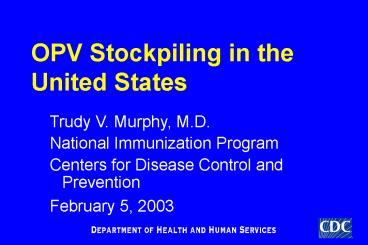OPV Stockpiling in the United States - PowerPoint PPT Presentation
1 / 20
Title:
OPV Stockpiling in the United States
Description:
1995 -1999 National Immunization Survey, parents of 1.9% - 3.1% of children ... Public health goal is to eradicate outbreak strain ... – PowerPoint PPT presentation
Number of Views:57
Avg rating:3.0/5.0
Title: OPV Stockpiling in the United States
1
OPV Stockpiling in the United States
Trudy V. Murphy, M.D. National Immunization
Program Centers for Disease Control and
Prevention February 5, 2003
2
Is the US at Risk of an Outbreak of
Poliomyelitis?
- US has high vaccination coverage
- 1995 -1999 National Immunization Survey, parents
of 1.9 - 3.1 of children reported child had no
poliovirus vaccine by 19-35 months of age - Western Hemisphere certified free of indigenous
wild poliovirus in 1994
3
Outbreaks of Poliomyelitis in Countries with
High Vaccine Coverage
- Pockets of under-vaccination -Religious
communities - -Vaccine objectors
- -Refugees, immigrants
Patriarca P. JID 1997175S165
4
Potential Sources of Neurovirulent Polioviruses
- Eradication of polioviruses incomplete
- Endemic areas
- Vaccine-derived strains
- Laboratory containment
- The U.S. remains at risk of an outbreak of
poliomyelitis
Patriarca P. JID 1997175S165
5
Emergency Response to an Outbreak of
Poliomyelitis in U.S.
- Inactivated (IPV) and live attenuated oral (OPV)
poliovirus vaccines induce similar levels of
individual protection after three doses - IPV and OPV differ in their risks and
effectiveness when used to control an outbreak of
poliomyelitis
6
OPV Vaccine of Choice in Outbreak Settings
- Public health goal is to eradicate outbreak
strain - Extensive experience using mass campaigns
demonstrates OPV interrupts transmission
polioviruses - Interferes with or reduces replication of
outbreak strain at mucosal level
7
OPV Halts Circulation of Poliovirus
- OPV used in Albania, 1996
- 80 population vaccinated in mass campaign
- 90 decrease in cases within 2 weeks
- No case poliomyelitis after second mass campaign
Prevots R. CID 199826419
8
IPV and Outbreaks of Poliomyelitis
- No example of successful control of an outbreak
using IPV - Countries that use all-IPV for routine
vaccination, used OPV for control of outbreaks
(Netherlands, Finland)
Hovi T, Lancet 198611427 Oostvogel PM. Lancet
1994344665
9
Challenges of Response to an Outbreak of
Poliomyelitis
- Vaccine acceptance among objectors may not be
optimal regardless of type - Risk of VAPP after OPV is established, but less
than the risk of poliomyelitis in an outbreak
10
Challenges of Response to an Outbreak of
Poliomyelitis
- IPV is vaccine of choice for
- immediate vaccination
- the immunodeficient and their contacts
- adults (usually)
- persons refusing OPV
11
U.S. Uses IPV for Routine Poliovirus Vaccination
- In January 2000, the ACIP recommended IPV for
routine vaccination against poliomyelitis to
avoid the rare but established risk of vaccine
associated paralytic poliomyelitis (VAPP) - OPV no longer is manufactured in U.S.
12
Options for Obtaining OPV
- Administer remaining U.S. licensed, expired OPV
as investigational new drug (IND), given adequate
potency, sufficient supply - Establish stockpile of non-U.S. OPV
- Administer under IND
- Administer as U.S. licensed product
13
Desirable Characteristics of OPV Product for U.S.
Stockpile
- Trivalent OPV
- Extensive (global) use, meets U.S. or WHO
standards for safety, potency - 4,000,000 doses available on staggered
timeline - Rotation with OPV in active market to avoid
replacing expired vaccine
14
Status of U.S. OPV Stockpile
- Interim stockpile of licensed, expired
Wyeth-Lederle OPV (IND) - First solicitation for non-U.S. made OPV
- Planned second solicitation for non-U.S. made OPV
- Hurdles to establish U.S. OPV stockpile
15
Potential Interim Stockpile Wyeth-Lederle OPV
(Expired)
- 800,000 doses, expired Nov. 2002
- Potency test quarterly Sept. 2002
- CDC application for IND incomplete
- Manufacturer requests no release of OPV unless
Government approves request for indemnification
(Public Law 85-804) and contract reflects
approval by Secretary of HHS
16
First Solicitation for StockpileNon-U.S. Made OPV
- Initiated June 1999 preference for product
licensed in U.S. - One respondent
- Product required IND
- Lacked desirable characteristics
- Liability issues unresolved
- Negotiations ended February 2002
17
Second Solicitation for StockpileNon-U.S. Made
OPV
- CDC intends to issue in near future
- 4,000,000 doses, trivalent OPV
- IND use (U.S. license preferred)
- One year option 9 additional years
- Liability issues remain
18
OPV under IND Covered byNational Childhood
Vaccine Injury Act
- OPV listed in Vaccine Injury Table
- Vaccine taxed on use
- No distinction made between investigational and
approved vaccines for purposes of injury
compensation - Final determination resides with court
August 2001
19
Hurdles to Establish OPV Stockpile for Emergency
Use in the U.S.
- Manufacturer interest
- Future demand for OPV uncertain
- Requirements to obtain IND (U.S. license)
perceived as onerous, expensive - Assurance of full indemnification
- CDC to hold IND
- Protocol, IRB
20
Conclusion
- All groups recommend OPV to control an outbreak
of poliomyelitis use of OPV is supported by
experience and scientific evidence - A stockpile of OPV meeting FDA requirements for
use is the foundation for preparedness in the
event of an outbreak of poliomyelitis in the U.S.































